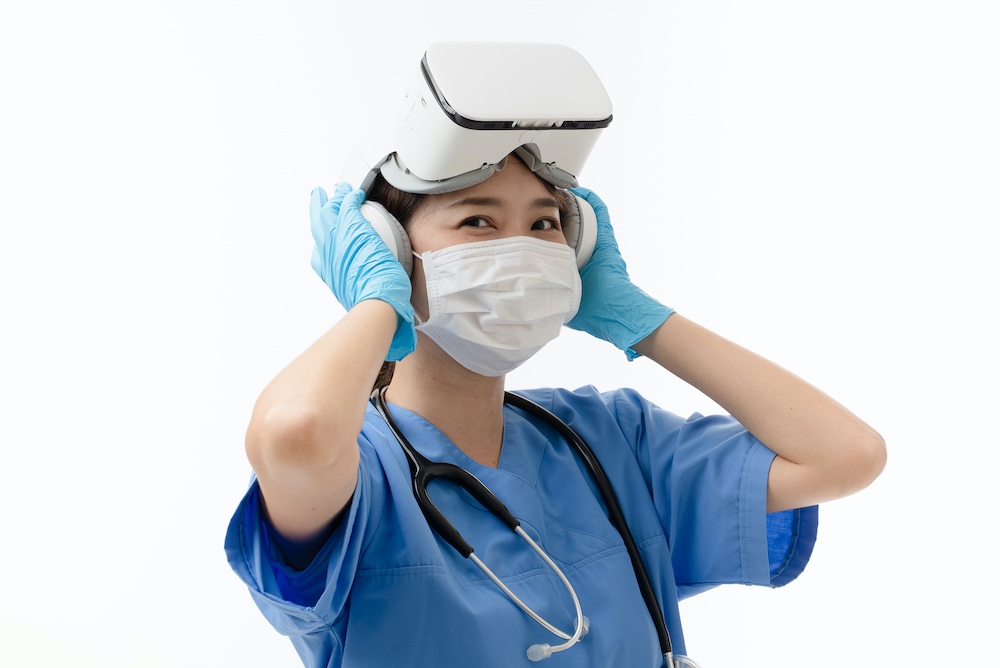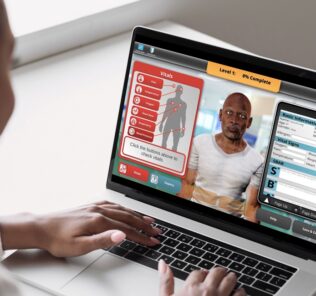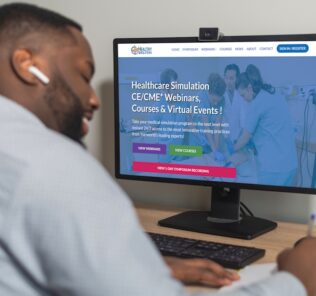SimX Allows for Quick Creation of VR Training Environments
The virtual reality (VR) industry has rapidly evolved into a cost-effective tool for both training and learning, especially across healthcare simulation. VR training effectiveness has shown to be superior to both classroom and electronic learning formats. This is a boon in today’s fast-paced world where employers have little time to train their employees. This HealthySimulation.com article details the effectiveness of VR training and explains how SimX allows medical simulation teams to practice their skills in virtual simulation environments.
Beyond demonstrating that VR training is more effective than traditional and electronic learning, employers must understand exactly how to gauge the effectiveness of VR training on their staff. Whether they oversee medical teams or military personnel, managers can implement VR training and easily measure the impact VR has on their workforce.
The problem with learning is that people often forget a large percentage of what they hear and read. Yet, the great news is that VR training effectiveness outshines many types of both traditional and electronic-based learning.
Sponsored Content:
VR Training Compared To Traditional Classroom Approaches
VR training programs allow people to remember more information because the practice involves experiential learning. When a person uses VR training to rehearse a skill, their learning retention increases to about 75%. (1) The act of physical skills practice helps people learn better when compared to many other traditional training approaches. Skills practice, including VR training, is more effective than any of the following at promoting learning:
- Engaging in discussion groups
- Making demonstrations
- Reading
- Participating in a lecture
- Watching and/or listening to a presentation
VR Training Compared To Other Electronic Learning Approaches
Someone may not be surprised to learn that VR training is more effective than classical learning approaches. However, learning that VR training is also more effective than many electronic learning techniques may come as a shock.
Sponsored Content:
Scientists from the University of Maryland (2) compared the effectiveness of learning through virtual environments with learning on electronic devices like a tablet or desktop computers. They discovered that people retain more information if they learn the info using VR environments. About 40 percent of people in the study scored higher on memory recall when they learned with VR instead of a computer or tablet.
These findings suggest that clinical simulation is an effective tool to use for both team training and virtual collaboration. That being said, SimX boasts the most advanced virtual reality simulation platform on the planet. With over 30 different virtual environments, and more than 300 tools and procedures, SimX allows for the quick creation of VR environments that can meet anyone’s needs.
VR Training Compared to Both Traditional Classroom and Electronic Learning Approaches
In a 2020 study (3) comparing VR training effectiveness with both classroom and electronic learning, VR came out on top. Knowing this fact is important for company managers and industry leaders regardingVR training for medical employees.
Workers in the U.S. generally spend only 1% of their time each week going through either training or development. This means that employers must use their time wisely — since they have such precious little time to improve employee productivity.
This is where VR training can be so vital to boosting medical employee performance. Regarding VR coursework, employees can complete training in a virtual environment four times faster (3) than when using an electronic device or learning in the classroom. This means VR training is best suited for today’s fast and evolving work environments.
As far as worker performance, employees need to feel confident when they apply the information they learn. This means they first need safe environments to rehearse difficult situations, such as giving constructive criticism to a fellow employee or responding to issues pertaining to diversity. After going over sensitive issues in a virtual environment, employees feel nearly 275 percent more confident to respond to these difficult situations while on the job. This figure dwarfs the confidence numbers from either electronic or classroom learning.
In addition to experiencing confidence, employees also need to feel emotionally connected to what they are learning. VR simulation allows workers to feel around 3.75 (3) times more emotionally bonded to what they have learned in virtual environments as compared to electronic and classroom learning situations.
Next, the 2020 study showed that VR learners tend to be more focused. (3) People may become distracted easily or overwhelmed when trying to pay attention and learn. That is why methods that can boost focus are a gold mine in terms of worker training.
Lastly, VR learning today is more cost-effective than many other traditional learning formats. Why? Because VR training allows employees to train while using more practice repetitions. This is especially cost-effective when those employees work inexpensive, uncommon, or even risky industries. An example of this is an orthopedic surgical team rehearsing a medical procedure on a virtual patient. Allowing this medical team to practice repeatedly can easily be more cost-effective than doing the same amount of training in a surgical room.
SimX allows healthcare teams to practice their skills in virtual environments. This offers several benefits, including enriching the learning experience and offering significant savings in healthcare training.
How To Evaluate VR Training Effectiveness for Employees
Establishing a system that accurately gauges VR training effectiveness is important. Knowing the general benefits of VR training is one thing, but organizations need a plan of action to ensure VR training programs actually work well for their specific medical team members. There are certain steps that organizations can take to verify how effective virtual reality skills training is on their medical teams.
Track Employee Performance During VR Training
People learn better when they actively practice a task. (4) Companies can take advantage of this fact, and monitor employees while they perform VR training. Since VR training represents a virtual environment similar to the actual work environment, employee improvement during VR training can be a strong sign their real-world skills at their job have also improved. Keeping statistics on how long completing a simulation would take for an employee is helpful. Tracking how much faster an employee finishes subsequent VR training sessions can verify their improvement in training.
Another way institutions can track employee performance is by analyzing the number of repetitions an employee needs to finish a task. As an employee improves at the specific skill on which they are training, their repetitions required to complete a task should decrease. This tells a manager that the employee is becoming more proficient at that particular skill they are learning.
Collect Employee Feedback After VR Training
Employees are the backbone of the company, so getting their sincere feedback about the VR training is vital. Having medical employees fill out surveys and share their opinions after their training is key to capturing their feedback.
Sample questions (6) to ask employees after their training are:
- Was the training relevant to your job duties?
- Did you find the training engaging?
- How confident do you feel about your job skills after completing the training program?
- How motivated are you to put your VR training into practice at your job?
- What specific facts and pieces of information did you learn in your training?
Accurate employee feedback helps a company match the training metrics with worker opinions. Having positive statistics from a VR training program — such as time to completion or number of repetitions (5) taken for a task — is not enough. Organizational leaders need to know their workers have also found the training to be personally positive and beneficial. If a medical employee finds the VR training helpful, this can improve their confidence in their real-world job tasks, for example.
Measure Employee Performance After VR Training
Gauging employee skill levels after the VR course is the final step in evaluating the effectiveness of VR training programs. Managers should measure their employees’ performance after they have completed the training — comparing the performance to the employees’ pre-training job performance. Company leaders must use their pre and post metrics to answer specific questions about their medical employees:
- Have they begun to use their new skills from VR training in their work?
- Is the employee making better decisions while on the job?
- Have they integrated information from the virtual environment into their daily work tasks?
Measuring employee performance after VR training helps organizational leaders gauge the effect that training has had on their business. This is important since VR training aims to improve a worker’s daily job performance.
SimX VR Training Can Revolutionize Your Workplace
Virtual reality training in the medical workplace represents the next step in the evolution of employee training. SimX offers world-class VR training that helps medical teams perform better at their jobs. When you compare VR training vs. traditional training, the differences are clear: VR training is faster, helps employees learn more, instills more worker confidence, keeps employees more engaged, and is cost-effective. For even more reasons to use VR for your education and training purposes, read our related article.
More About SimX
SimX brings virtual and augmented reality to medical simulation training. The company’s product is the first comprehensive professional-grade VR medical simulation system and is used to train physicians, nurses, and other allied health professionals. The SimX platform allows medical teams to replace expensive mannequins with incredibly flexible simulated patients, backed by a robust physiology engine.
Learn More About SimX
1. https://www.educationcorner.com/the-learning-pyramid.html
2. https://www.sciencedaily.com/releases/2018/06/180613162613.html
3. https://www.pwc.com/us/en/tech-effect/emerging-tech/virtual-reality-study.html
4. https://news.harvard.edu/gazette/story/2019/09/study-shows-that-students-learn-more-when-taking-part-in-classrooms-that-employ-active-learning-strategies/
5. https://elearningindustry.com/vr-training-analytics-user-data-to-measure-performance-outcomes
6. https://elearningindustry.com/vr-training-analytics-user-data-to-measure-performance-outcomes
Lance Baily, BA, EMT-B, is the Founder / CEO of HealthySimulation.com, which he started in 2010 while serving as the Director of the Nevada System of Higher Education’s Clinical Simulation Center of Las Vegas. Lance also founded SimGHOSTS.org, the world’s only non-profit organization dedicated to supporting professionals operating healthcare simulation technologies. His co-edited Book: “Comprehensive Healthcare Simulation: Operations, Technology, and Innovative Practice” is cited as a key source for professional certification in the industry. Lance’s background also includes serving as a Simulation Technology Specialist for the LA Community College District, EMS fire fighting, Hollywood movie production, rescue diving, and global travel. He and his wife live with their two brilliant daughters and one crazy dachshund in Las Vegas, Nevada.
Sponsored Content:


















